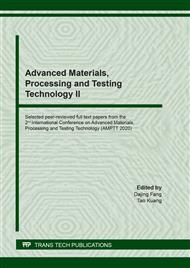p.112
p.125
p.134
p.147
p.153
p.159
p.165
p.170
p.176
The Influence of Rapid Prototyping Technology on Optimization of Automobile Energy-Absorbing Box
Abstract:
To optimize the structure of the automobile energy-absorbing box and obtain the energy-absorbing box structure with improved impact energy absorption property, and apply it to the structure of automobile energy absorption box, test piece of crystal lattice structure and polycrystalline structure of energy-absorbing box are designed via rapid prototyping technology in this study Four different crystal lattice structures of triangle, quadrangle, hexagon, and hollow lattice structure are designed respectively. And their mechanical properties, impact energy absorption properties, and impact properties are tested. The results show that the wall thickness of the four lattices differs greatly when the quality of all crystal lattice structures is 17.8g. The compressive strength and yield strength of the hollow crystal lattice structure test piece are the largest, reaching 51.1Mpa and 69.2Mpa respectively. The maximum compression modulus of the hexagonal lattice test piece is 1462.1, followed by the hollow crystal lattice structure test piece, whose compression modulus value is 1341. The minimum absorption energy of the hollow lattice structure energy-absorbing box test piece is 2847.99J. The minimum impact value of the hollow lattice structure energy-absorbing box test piece is 69.251KN, and the impact value of triangle structure energy-absorbing box test piece is 118.11 KN. The effective impact time of the drop weight test of the hollow lattice structure energy-absorbing box test piece is only 0.08s, the peak value of the impact acceleration is 28.96g, and the maximum load of the test piece is 26.95KN. According to the comprehensive indicators, the hollow lattice structure energy-absorbing box test piece designed based on rapid prototyping technology has improved the impact energy absorption property of the automobile energy-absorbing box.
Info:
Periodical:
Pages:
153-158
Citation:
Online since:
January 2021
Authors:
Price:
Сopyright:
© 2021 Trans Tech Publications Ltd. All Rights Reserved
Share:
Citation:


